Danny Draven started his directing career with the famous scifi/horror power house Full Moon Pictures. He has directed eight films and since moved into editing; cutting thirty-nine films and counting. His new book ‘The Filmmaker’s Book of the Dead: How to Make Your Own Heart-Racing Horror Movie’ reveals all of his secrets to putting together and distributing a low budget flick.
Trevor: You’ve done a lot of editing work lately, is that by choice? How did you make the move from director to editor?
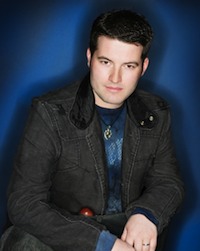 Danny Draven: I’ve been an editor for a really long time. I’m a member of the Motion Pictures Editing Guild and I own a small post production company called Darkworld Post. We handle all of Full Moon’s post production work and a lot of freelance work for other people as well. An indie filmmaker might be looking for someone to author a bluray and they could come to my company. We give great rates for indie filmmakers. It’s a business and a lot of the editing stuff I do comes out of my company. I think I’ve edited about thirty feature length films at this point. The last one we did, Puppet Master 9 Axis of Evil came out on bluray and dvd and so did Killjoy 3. Next is Gingerdead Man 3 and then Evil Bong 3. I’ve edited about every Full Moon movie that’s come out in the past ten years, but I also edit for SyFy channel. I just did a big spider movie for them called Ice Spiders. I definitely work on a regular basis. If you could direct all day long that would be great, but you can’t direct a movie every week. So in the meantime I do a lot of editing. If you’re a director you really should know how to edit and that will definitely make you a stronger director in the long run.
Danny Draven: I’ve been an editor for a really long time. I’m a member of the Motion Pictures Editing Guild and I own a small post production company called Darkworld Post. We handle all of Full Moon’s post production work and a lot of freelance work for other people as well. An indie filmmaker might be looking for someone to author a bluray and they could come to my company. We give great rates for indie filmmakers. It’s a business and a lot of the editing stuff I do comes out of my company. I think I’ve edited about thirty feature length films at this point. The last one we did, Puppet Master 9 Axis of Evil came out on bluray and dvd and so did Killjoy 3. Next is Gingerdead Man 3 and then Evil Bong 3. I’ve edited about every Full Moon movie that’s come out in the past ten years, but I also edit for SyFy channel. I just did a big spider movie for them called Ice Spiders. I definitely work on a regular basis. If you could direct all day long that would be great, but you can’t direct a movie every week. So in the meantime I do a lot of editing. If you’re a director you really should know how to edit and that will definitely make you a stronger director in the long run.
T: On ‘Horror Vision’ you worked with cinematographer Mac Ahlberg who is a fairly big name to get on such a small film. What was your working relationship like?
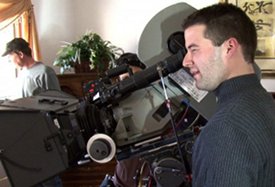 DD: Ya, Mac Ahlberg shot a lot of big films like Innocent Blood for John Landis, Striking Distance with Bruce Willis and Beverly Hills Cop 3. He also shot a lot of horror and Stuart Gordon stuff like Re-Animator, From Beyond, Dolls, House and DeepStar Six. All these great movies. He’s a veteran cinematographer. And then on Horror Vision somehow someone convinced him to work on this run and gun movie. And Mac at the time was around eighty years old. I was like twenty-one. If you look at the behind the scenes you can kind of see some of the crazy stuff we did. We hung off of cars on open roads and here Mac is this eighty year old man leaning off the back of a car to try and get shots with the camera on his shoulder. Incredibly ridiculous and dangerous stuff. I’d work with him on every movie if I could, but I think he’s retired now. We worked together again on Death Bed. He’s good friends with Stuart Gordon, which is how I wound up meeting Stuart and producing and directing Death Bed. It’s amazing, in the film business one person always leads to another and another. It’s a very small community, especially in the horror world.
DD: Ya, Mac Ahlberg shot a lot of big films like Innocent Blood for John Landis, Striking Distance with Bruce Willis and Beverly Hills Cop 3. He also shot a lot of horror and Stuart Gordon stuff like Re-Animator, From Beyond, Dolls, House and DeepStar Six. All these great movies. He’s a veteran cinematographer. And then on Horror Vision somehow someone convinced him to work on this run and gun movie. And Mac at the time was around eighty years old. I was like twenty-one. If you look at the behind the scenes you can kind of see some of the crazy stuff we did. We hung off of cars on open roads and here Mac is this eighty year old man leaning off the back of a car to try and get shots with the camera on his shoulder. Incredibly ridiculous and dangerous stuff. I’d work with him on every movie if I could, but I think he’s retired now. We worked together again on Death Bed. He’s good friends with Stuart Gordon, which is how I wound up meeting Stuart and producing and directing Death Bed. It’s amazing, in the film business one person always leads to another and another. It’s a very small community, especially in the horror world.
T: Last year you released ‘Ghost Month’, an independent film you made separate from Full Moon. What was your experience like on that film?
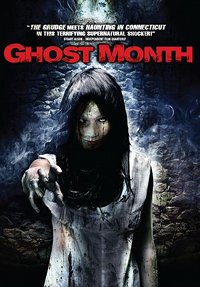 DD: Ghost Month was a project that had nothing to do with Full Moon. It had one-hundred percent private funding that I raised to make this Asian influenced ghost movie set in the desert. We shot it up in the mountains near Las Vegas, what most people don’t realize is that it’s actually quite cold there in the winter. It took ten days to shoot and we used 35mm film, which was a first for me as a lot of the other movies we just couldn’t afford film. We had always shot on video. This movie was special and I wanted to shoot it on film. The same low budget rules applied, we didn’t have a lot of money but what money we did have got spent on film. It’s very expensive to shoot on 35mm. It took awhile for it to come out. We actually shot it in December of 2006, but it didn’t come out until 2009 for all kinds of bizarre reasons. It’s on dvd and bluray, but it looks better in bluray. Definitely check it out if you like ghost stories, if you’re looking for gore and breasts it might not be your cup of tea.
DD: Ghost Month was a project that had nothing to do with Full Moon. It had one-hundred percent private funding that I raised to make this Asian influenced ghost movie set in the desert. We shot it up in the mountains near Las Vegas, what most people don’t realize is that it’s actually quite cold there in the winter. It took ten days to shoot and we used 35mm film, which was a first for me as a lot of the other movies we just couldn’t afford film. We had always shot on video. This movie was special and I wanted to shoot it on film. The same low budget rules applied, we didn’t have a lot of money but what money we did have got spent on film. It’s very expensive to shoot on 35mm. It took awhile for it to come out. We actually shot it in December of 2006, but it didn’t come out until 2009 for all kinds of bizarre reasons. It’s on dvd and bluray, but it looks better in bluray. Definitely check it out if you like ghost stories, if you’re looking for gore and breasts it might not be your cup of tea.
T: Do you think going from video to 35mm is worth the extra money?
DD: I love film. If I could shoot everything on film I would. One process is digital and the other is photo chemical, it’s two very different kinds of capture. But on a low budget film nowadays you probably really want to stick with video.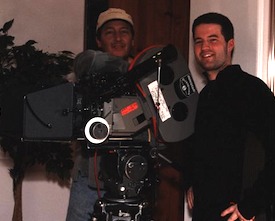 Your film is going to eat up so much of your money. Believe me when I tell you this. On Ghost Month I only wanted to shoot around 35,000 feet of film and we ended up shooting 75,000. You have the cost of film, the cost of developing and you have the cost of telecining. Nowadays you want to telecine everything to hd, you don’t want to go to standard def, but that’s very expensive. We’re talking about tens of thousands of dollars here, not like a thousand bucks here or there. So if you’re think of shooting a feature film on film then your budget isn’t going to be five grand, it’s going to be a lot more. Maybe if you’re going to shoot a short then ok, but I would say nowadays it’s best to just stick with the digital hd format. Remember with low budget you might have an actor that doesn’t hit their marks or a cameraman that doesn’t know what they’re doing and constantly messing up focus. On film you’re going to waste a lot of money on mistakes, but with video who cares, you can shoot as much as you want.
Your film is going to eat up so much of your money. Believe me when I tell you this. On Ghost Month I only wanted to shoot around 35,000 feet of film and we ended up shooting 75,000. You have the cost of film, the cost of developing and you have the cost of telecining. Nowadays you want to telecine everything to hd, you don’t want to go to standard def, but that’s very expensive. We’re talking about tens of thousands of dollars here, not like a thousand bucks here or there. So if you’re think of shooting a feature film on film then your budget isn’t going to be five grand, it’s going to be a lot more. Maybe if you’re going to shoot a short then ok, but I would say nowadays it’s best to just stick with the digital hd format. Remember with low budget you might have an actor that doesn’t hit their marks or a cameraman that doesn’t know what they’re doing and constantly messing up focus. On film you’re going to waste a lot of money on mistakes, but with video who cares, you can shoot as much as you want.
T: How did you develop a directing style enough to where Full Moon was comfortable with giving you a budget and letting you run with a crew? Did you have a demo reel at that point?
 DD: No I didn’t have a demo reel, but I had done some stuff. I went to film school and got a bachelor’s degree in film production. But honestly all the stuff I learned I didn’t learn it there. In film school I was turned onto a lot of things I wouldn’t have been had I not gone, like different directors, theory and history. But as far as actual practical experience, no absolutely not. All that stuff was learned by making my own films. So no I didn’t have a demo reel, but I had some short films that I made in school. Those were no money – shot in my apartment – pretty dreadful stuff. We were shooting on film as well and it’s not like nowadays when you can go out and get a high end digital camera and get a great image. We were using Bolex 16mm cameras so we had to have a decent amount of light to expose the film. And we had to cut it on Steenbeck flatbed film editors where we were actually cutting film. This wasn’t all that long ago, 1998/1999. They had digital editing bays as well, but they really wanted us to start out on film and work our way up to digital for some reason. So I had a tape of my stuff but I didn’t really have a demo reel. It wasn’t anything that I wanted to show around, and it didn’t factor into getting a directing job at Full Moon. But you really should have a demo reel of some kind even if you’re going to shoot it yourself. Even if you’re really low budget and you just want to shoot a scene, write it out. Hire some decent actors, for God’s sake not your friends or family. Light the scene, shoot it and edit. If you don’t have anything else that’s a good way to get some material. You definitely need something to show because everybody’s going to want to see something. “Oh you know, show me what you’ve done.” But honestly, these days, and I’m just going to be completely straight here, the chances of you getting noticed off your reel alone are pretty much zero. If you really want to be a filmmaker you have to just do it yourself. Unless you were born into the Spielberg family. If you’re on the outside, getting on the inside is very very difficult. My philosophy has always been if you want to make a movie don’t wait on anybody else because you might be waiting a very long time.
DD: No I didn’t have a demo reel, but I had done some stuff. I went to film school and got a bachelor’s degree in film production. But honestly all the stuff I learned I didn’t learn it there. In film school I was turned onto a lot of things I wouldn’t have been had I not gone, like different directors, theory and history. But as far as actual practical experience, no absolutely not. All that stuff was learned by making my own films. So no I didn’t have a demo reel, but I had some short films that I made in school. Those were no money – shot in my apartment – pretty dreadful stuff. We were shooting on film as well and it’s not like nowadays when you can go out and get a high end digital camera and get a great image. We were using Bolex 16mm cameras so we had to have a decent amount of light to expose the film. And we had to cut it on Steenbeck flatbed film editors where we were actually cutting film. This wasn’t all that long ago, 1998/1999. They had digital editing bays as well, but they really wanted us to start out on film and work our way up to digital for some reason. So I had a tape of my stuff but I didn’t really have a demo reel. It wasn’t anything that I wanted to show around, and it didn’t factor into getting a directing job at Full Moon. But you really should have a demo reel of some kind even if you’re going to shoot it yourself. Even if you’re really low budget and you just want to shoot a scene, write it out. Hire some decent actors, for God’s sake not your friends or family. Light the scene, shoot it and edit. If you don’t have anything else that’s a good way to get some material. You definitely need something to show because everybody’s going to want to see something. “Oh you know, show me what you’ve done.” But honestly, these days, and I’m just going to be completely straight here, the chances of you getting noticed off your reel alone are pretty much zero. If you really want to be a filmmaker you have to just do it yourself. Unless you were born into the Spielberg family. If you’re on the outside, getting on the inside is very very difficult. My philosophy has always been if you want to make a movie don’t wait on anybody else because you might be waiting a very long time.
T: What are your inspirations? When you go out to make a film do you like to watch other horror movies to get in the mood?
DD: Well I’m obviously a horror fan and I’ve seen pretty much everything. These days I don’t know. I don’t really watch as much horror anymore and if I do it’s probably foreign or old. The best horror movie I’ve seen in a long time is Let the Right One In. That movie was just fantastic. That and The Orphanage. There’s a couple of them. Or stuff that’s really old like The Entity with Barbara Hershey. Stuff from the eighties I’m a big fan of the Hellraisers. That stuff has a special charm to it that’s lost now-a-days. Depends on what I’m making. If I’m making something and I want to be inspired I might watch a lot of vampire movies if it’s a vampire movie. Or read a book about it. I don’t really watch other movies for inspiration. But when I see other films I do get inspired.
T: You’ve worked with a lot of great low budget guys like J.R. Bookwalter, Charles Band and Stuart Gordon. Have you ever been intimidated when working with anyone?
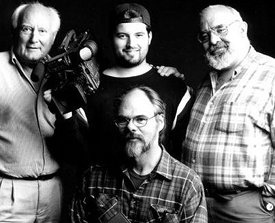 DD: No not really. Stuart I was… I wouldn’t say star struck, but I was just glad to be there and working with somebody who’s done a lot of my favorite horror films like Re-Animator and From Beyond. I’ve learned so much from him, more than anybody else. Especially about directing actors. And I think he learned a lot from me as well as far as making low budget movies go. So he was really the only person that I had a little bit of “oh wow” with. Charlie Band, who I talked to pretty much everyday, we’re still very connected. I do all of their post production and am very involved in all the Full Moon films. But I’ve known him for a very long time, ten years now I think. He always amazes me though because he’s always making something. His goal I think is to make a movie a month, but I don’t think we’ve quite done that yet. It’s usually a few movies a year. But still a few movies a year is a hell of a lot more than most people ever get to make. I also work a lot with David DeCoteau. I edit a lot of his films and he’s also a very prolific filmmaker. Always making something. It’s cool to be able to hang around guys like that, who keep making stuff because it inspires you to try to keep going as well. But these days it’s tough. It’s different than it was ten years ago as far as selling a film. Anybody can get a camera and shoot a movie now, but the selling part has become very difficult. So if you’re going to make a movie and you put $100,000 into it, be careful and don’t think you’re going to get that money back. You really have to shoot it for as little as you can but still try and make a good quality movie. For God’s sake don’t put it on a credit card like me and think “but once it sells I’ll be able to pay all these credit cards off”. You’re completely delusional at that point.
DD: No not really. Stuart I was… I wouldn’t say star struck, but I was just glad to be there and working with somebody who’s done a lot of my favorite horror films like Re-Animator and From Beyond. I’ve learned so much from him, more than anybody else. Especially about directing actors. And I think he learned a lot from me as well as far as making low budget movies go. So he was really the only person that I had a little bit of “oh wow” with. Charlie Band, who I talked to pretty much everyday, we’re still very connected. I do all of their post production and am very involved in all the Full Moon films. But I’ve known him for a very long time, ten years now I think. He always amazes me though because he’s always making something. His goal I think is to make a movie a month, but I don’t think we’ve quite done that yet. It’s usually a few movies a year. But still a few movies a year is a hell of a lot more than most people ever get to make. I also work a lot with David DeCoteau. I edit a lot of his films and he’s also a very prolific filmmaker. Always making something. It’s cool to be able to hang around guys like that, who keep making stuff because it inspires you to try to keep going as well. But these days it’s tough. It’s different than it was ten years ago as far as selling a film. Anybody can get a camera and shoot a movie now, but the selling part has become very difficult. So if you’re going to make a movie and you put $100,000 into it, be careful and don’t think you’re going to get that money back. You really have to shoot it for as little as you can but still try and make a good quality movie. For God’s sake don’t put it on a credit card like me and think “but once it sells I’ll be able to pay all these credit cards off”. You’re completely delusional at that point.
T: How do you feel about The Asylum? Talk about prolific, those guys also try and put out a movie a month. Have you ever thought about going to work with another company or are you exclusively with Full Moon?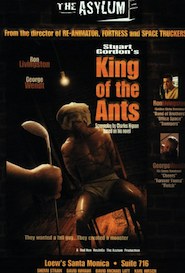
DD: No I am not exclusively with Full Moon, they’re just one client of many. I’m familiar with The Asylum, David Michael Latt and all that. I know they also do all these very similar type shows. Probably with a little more money. I think Stuart did a movie with them actually called King of the Ants. There’s actually a couple of other companies like them as well. Guys like that have been doing this for awhile and it’s fantastic. It keeps movies like these being made and gives people jobs. They typically don’t hire first time directors though. The best low budget director is one who’s made hundreds of low budget movies. They know how to get in there and get it done. A first time director might take something that was supposed to be done in six days, and now it’s taking twelve.
T: Is there anything we can look forward to from Danny Draven in the future?
DD: If you haven’t checked out the new Puppet Master movie, Axis of Evil… I didn’t direct that one, it was David DeCoteau, I just edited it and did some of the post work on it. There’s Gingerdead Man 3 coming out soon. Billy Butler directed that. It’s called Gingerdead Man 3-D: Saturday Night Cleaver. It’s going to be pretty crazy. I’ve edited all the Gingerdead Man movies. Definitely there’s more stuff coming from Full Moon and I’m always involved with that.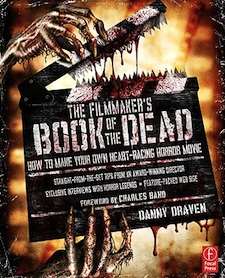 I also just wrote this book The Filmmaker’s Book of the Dead: How to Make Your Own Heart-Racing Horror Movie. It’s three hundred and twenty page, full color. It’s great if you’re interested in filmmaking, it doesn’t have to be just horror although the book has a lot of horror examples in it. The information can be used with any genre whether comedy, web series or short film it doesn’t matter. But if you’re interesting in making movies with a low budget and you need a place to start or maybe you’ve already made some films and you want to know more about distribution or quality control and marketing definitely check out the book. It took me a year to write it, I sat down and really put down every piece of insider information I could possible think of. The other cool thing is, even of you don’t want to make movies and you’re just a horror fan, there’s interviews in there. I have at least fifteen to twenty interviews with all kinds of people such as Robert Englund, Robert Kurtzman, James Wan, Charles Band, David DeCoteau, Lloyd Kaufman, Stuart Gordon, Tom Savini, John D. LeMay, Reggie Bannister and many more. They’re very specific interviews about the craft of filmmaking and not about what it was like to work with so and so. And Ghost Month is still out there available to check out. I’m working on a few other things at the moment.
I also just wrote this book The Filmmaker’s Book of the Dead: How to Make Your Own Heart-Racing Horror Movie. It’s three hundred and twenty page, full color. It’s great if you’re interested in filmmaking, it doesn’t have to be just horror although the book has a lot of horror examples in it. The information can be used with any genre whether comedy, web series or short film it doesn’t matter. But if you’re interesting in making movies with a low budget and you need a place to start or maybe you’ve already made some films and you want to know more about distribution or quality control and marketing definitely check out the book. It took me a year to write it, I sat down and really put down every piece of insider information I could possible think of. The other cool thing is, even of you don’t want to make movies and you’re just a horror fan, there’s interviews in there. I have at least fifteen to twenty interviews with all kinds of people such as Robert Englund, Robert Kurtzman, James Wan, Charles Band, David DeCoteau, Lloyd Kaufman, Stuart Gordon, Tom Savini, John D. LeMay, Reggie Bannister and many more. They’re very specific interviews about the craft of filmmaking and not about what it was like to work with so and so. And Ghost Month is still out there available to check out. I’m working on a few other things at the moment.
More Info:
Buy Danny Draven’s The Filmmaker’s Book of the Dead: How to Make Your Own Heart-Racing Horror Movie, Ghost Month and these other great DVDs from Full Moon on Amazon.com

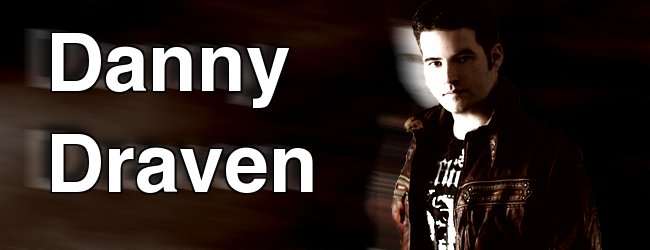
I’m not too familiar with his work. I got PUPPET MASTER: AXIS OF EVIL recently, and its not bad, but not among the best of the franchise. Editing in footage from the original just makes me want to watch the original. Not sure why some of the sound effects were changed, or why Toulon (William Hickey’s) dialogue was cut out.